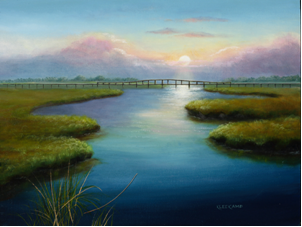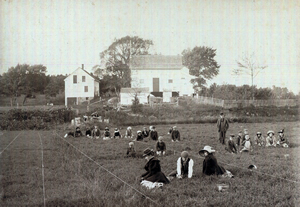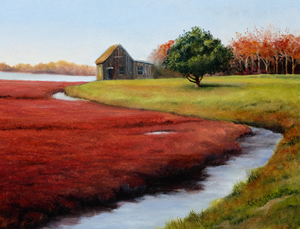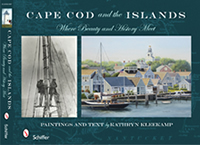
Where Beauty & History Meet
by Katie O’Sullivan
Local Author & Artist Releases New Book

by Kathryn Kleekamp
Retiring to Cape Cod, Kathryn Kleekamp found herself inspired by the natural beauty surrounding her and discovered a new and unexpected career.
She not only embraced a passion for art, but found she had a talent for realistic painting and a keen interest in the history of the Cape and islands.
Kathryn brings these passions together in her new 176 page, hardcover book, Cape Cod and the Islands: Where Beauty and History Meet.
The book features fifty of Kathryn’s original oil paintings depicting land and seascapes, along with dozens of rare historic photographs, informative text and traditional Cape and Island recipes.
Kathryn brings to life the heartbeat of those who farmed the land, fished the seas, captained the great schooners and waited at home for a loved one’s return. The essence of the book is a collection of historic vignettes looking at the major influences that made Cape Cod, Nantucket and Martha’s Vineyard what they are today.
Excerpt from her book:
“Cape Cod’s cranberry history began when the Indians introduced them to the Pilgrims in the early 1600’s. Wampanoag legend says the cranberry was carried from heaven in the beak of a white dove as a gift from the Great Spirit. The dove dropped the berry into a bog where in time it grew abundantly.
“Native American tribes called cranberries sassamanash and ibimi, which both translate into “bitter berry.” Colonists called them “crane-berry” because the blossom and stem resembled a crane’s head and neck. Indeed a gift from God, cranberries were very important in the diets of the first English colonists. Having consisted on a diet of salted meat and dry biscuits for many weeks, and lacking fresh fruit, many developed scurvy from a vitamin C deficiency.
“The berries, rich in this vitamin, were boiled or dried and added to sauces and baked goods. In addition, the Wampanoag Indians who had been using cranberries for hundreds of years taught the colonists about their medicinal properties. They could be brewed to make poultices for wounds and made into soothing teas to ease stomach problems and cleanse the urinary tract. Dye made from the berries provided crimson-tinted wool and cloth. A recipe for cranberry sauce first appeared in a Pilgrim cookbook in 1633.”
Kathryn says her inspiration to create is evoked by the Cape’s “extraordinary beauty. ”Although the magnificent ocean vistas, spectacular sand dunes, and quiet marshes bring people back year after year, Kathryn wanted to share the remarkable stories of courage and enterprise by those who settled the land and shaped its character for the more inquiring visitor.
Return to Summer '09 Literary Women page

c.1880. Courtesy Harwich Historical Society.
“I first thought of compiling this book,” Kathryn writes in her Introduction, “as I witnessed the interest of those who took the time to read the historical information I put on the back of my art prints. I realized that I was giving the reader snippets but they wanted more…My biggest challenge has been to refine almost four hundred years of history into a modest volume.”



Cape Cod and the Islands:
Where Beauty and History Meet
is available fromSchiffer Publishing
Kathryn Kleekamp is represented by:
My Sister’s GallerySandwich Art Gallery

After Kathryn Kleekamp retired from a 30-year career as a clinical microbiologist, her move to Cape Cod began a pleasurable new career of oil & watercolor painting.
She is an artist member of the Cape Cod Art Association. Her work is in private collections all over the United States and Europe.
Kathryn lives with her husband, Charles, in Sandwich. She is the mother of three adult children.
You can email Kathryn Kleekamp atkleekamp@verizon.net
Upcoming Book Signings:
Brewster Bookstore
July 28, 10-12 pm
2648 Main Street Brewster
(508) 896-6543
Bourne Council on Aging
August 4 1:30
239 Main Street
Buzzards Bay (508) 759-0653
Brewster Ladies Library
August 11, 6:30 pm
1822 Main St. Brewster (508) 896-3913
Kathryn Kleekamp will also be doing an outdoor Sandwich Artisan Show at the Sandwich Public Library on the following Saturdays:
- August 22
- September 5
- September 26
Katie O'Sullivan is the Editor of this magazine. She lives in Harwich with her family and writes contemporary fiction.

